
Latinisation of names
Latinisation (or Latinization)[1] of names, also known as onomastic Latinisation, is the practice of rendering a non-Latin name in a modern Latin style.[1] It is commonly found with historical proper names, including personal names and toponyms, and in the standard binomial nomenclature of the life sciences. It goes further than romanisation, which is the transliteration of a word to the Latin alphabet from another script (e.g. Cyrillic). For authors writing in Latin, this change allows the name to function grammatically in a sentence through declension.
Not to be confused with Romanization, the conversion of text written in another script into Latin (or Roman) letters, or Liturgical Latinisation.
In a scientific context, the main purpose of Latinisation may be to produce a name which is internationally consistent.
Latinisation may be carried out by:
In English, place names often appear in Latinised form. This is a result of many early text books mentioning the places being written in Latin. Because of this, the English language often uses Latinised forms of foreign place names instead of anglicised forms or the original names.
Examples of Latinised names for countries or regions are:
Historical background[edit]
During the age of the Roman Empire, translation of names into Latin (in the West) or Greek (in the East) was common. Additionally, Latinised versions of Greek substantives, particularly proper nouns, could easily be declined by Latin speakers with minimal modification of the original word.[4]
During the medieval period, after the Empire collapsed in Western Europe, the main bastion of scholarship was the Roman Catholic Church, for which Latin was the primary written language. In the early medieval period, most European scholars were priests and most educated people spoke Latin, and as a result, Latin became firmly established as the scholarly language for the West.
By the early 19th century, Europe had largely abandoned Latin as a scholarly language (most scientific studies and scholarly publications are printed in English), but a variety of fields still use Latin terminology as the norm. By tradition, it is still common in some fields to name new discoveries in Latin. And because Western science became dominant during the 18th and 19th centuries, the use of Latin names in many scholarly fields has gained worldwide acceptance, at least when European languages are being used for communication.